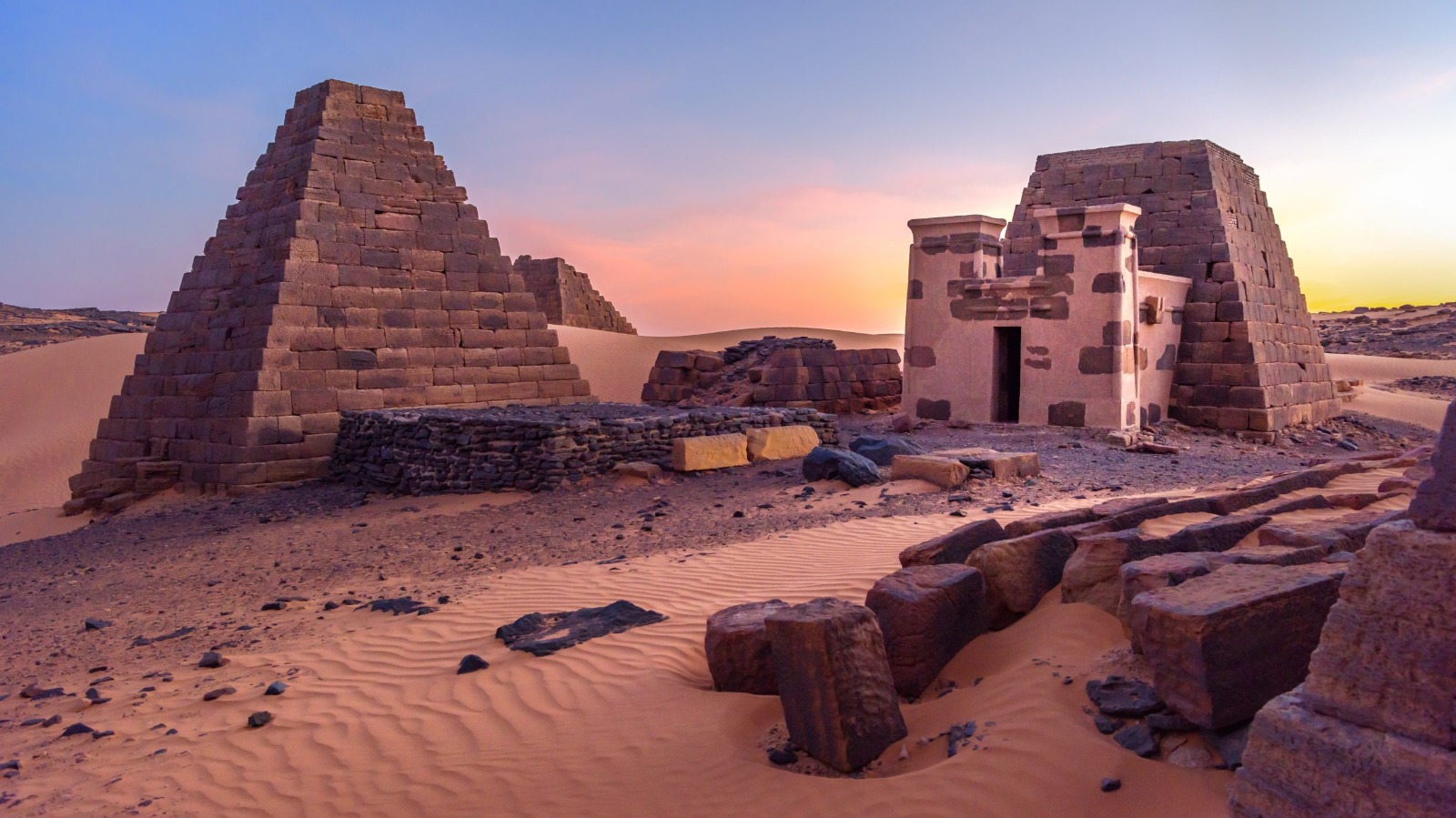The youngest country on earth is South Sudan. In 2011, they broke off from Sudan into their own country. However, the story of the youngest country has ancient roots, and many of us don’t really give this region the time of day. So, for this week, to advance the brief history series, let’s talk about Sudan and its long, long history.
Alright, so let’s start with a few quick facts about the country of Sudan. It’s located in northeastern Africa, and its name comes from Arabic, meaning “the land of the black people.” Before it split into two separate countries in 2011, it was the largest country in Africa, with a size of about a quarter of the United States. The one thing about Sudan that really sticks out that you need to know, though, is that it’s always been at this cultural crossroads between the Arabic Islamic Middle East, African traditional cultures to the south, and the Mediterranean culture to the north.
So, let’s start by going back to the first known entity that existed in Sudan, at least in recorded history. Let’s talk about the ancient kingdom of Kush. For those who aren’t in the know, Sudan has a history very much entwined with ancient Egypt. Both of them followed the Nile River, so the Sudanese people have always had this cultural relationship with the Egyptians. The earliest sources that we have about Sudan come from ancient Egypt. The word Kush even comes from the ancient Egyptian word for “wretched people.” So, yeah, you can see that this is going to be a bit of an antagonistic relationship.
That being said, Sudan did have a lot of influence from ancient Egyptian culture and their language. A lot of the Egyptian gods were actually worshipped in ancient Kush as well, and there was a lot of trade that happened. A lot of the gold that went to Egypt came from the ancient kingdom of Kush, as well as ivory, incense, and a red gem called carnelian. Ancient Egypt also practiced slavery, so often slaves were brought up from Sudan. Kushite soldiers were a large part of the Egyptian military, and you might also hear them referred to in the history books as Nubians.
However, the two societies were at arm’s length until the Middle Kingdom in Egypt. Around that time, the Egyptians started to build forts around the Nile River and had a stronger emphasis on making sure that gold flowed from Kush into Egypt. So, there was a lot more of an exploitative relationship. This all ended when a group of Canaanite nomads called the Hyksos conquered the Egyptians. After that conquest, when Egypt had basically crumbled for a little while, they cut off their relationship with Kush. In the wake of Egypt’s destruction at the end of the Middle Kingdom, the Kushites were able to re-establish an indigenous monarchy.
That is until the rulership of Pharaoh Ahmose I, who is known for reincorporating Kush into the Egyptian kingdom once more. From then on, the Egyptians ruled Kush via a Viceroyalty in the region, and the Egyptians maintained the loyalty of the Kushite people by taking the children of prominent chiefs in the region and bringing them to the Pharaoh’s court to serve as pages. This changed a lot in Kush. This is when the Egyptian religion began to move in, and the more well-off Kushites began to worship the Egyptian gods in earnest. It was also when the Egyptian language made it to Kush. The ancient religion of the Egyptians would actually persist in Kush and in Sudan until the 6th century.
As the ancient Egyptian kingdom collapsed, the Kushites began to see themselves as the cultural inheritors of the Egyptian way. In the 11th century BCE, you do see the end of Egyptian rulership over Kush, which would continue all the way until the 19th century. Of course, with the loss of the Egyptians came the loss of writing in the region as well. A lot of the historical record starts to get a little sparse until several centuries later. It wasn’t until the 8th century BCE that the Kushites began to emerge on the world stage as an independent power. Except that now, the tables would be turned, and the Kushites were going to expand their influence into Egypt.
A Kushite king named Kashta led an invasion into Upper Egypt in southern Egypt and ruled from Thebes, one of the major cities in the Egyptian kingdom, for ten years. His successor, Piye, actually conquered the Egyptians. So, for a while, there was an Egyptian kingdom ruled by a Kushite royal family, which meant that there were, at least for some time, black Pharaohs. The last Kushite Pharaoh ruled until 663 BCE, and it was not due to any sort of internal strife, but due to the common thing that leads to the end of Egyptian civilizations: foreign invasion.
For the entire time the Kushites ran Egypt, they were in a cold war with a neighboring Middle Eastern empire called the Assyrians. In 663 BCE, the Assyrians invaded and conquered Egypt. The Kushites were pushed back into Nubia afterwards, and the Assyrians installed a native kingdom in Egypt. This was a critical blow, and over the next few years, it appears that the Kushite Empire collapsed in some form or another. Again, historical records are a little vague here. The new indigenous kingdom that the Assyrians put in place moved into Nubia and attacked the Kushite Empire. In 590 BCE, the Egyptians pushed into and conquered and sacked the Kushite capital of Napata. The Kushites moved to a new city called Meroë.
From here on, historians tend to not refer to it as the Kushite Empire anymore but as the Meroitic Empire. They actually flourished a lot in this period. They built stone markers to document their own history, built pyramids very much like in Egypt, albeit a little bit smaller as tombs, and even made a new Meroitic alphabet based on the language indigenous to the region, no longer using Egyptian law. The Meroitic Empire had a very centralized government with an interesting form of succession. It was matrilineal, based on the mother’s bloodline. It also relied on handing down leadership to siblings before passing on to the next generation, meaning younger brothers would rule in Meroë until the end of all the siblings in that generation, then move on to the next level. This likely led to a lot of staccato succession, with a long string of old men all dying before moving on to the next generation.
As it did throughout history, a lot of its trade was linked to the Nile River, meaning they were still linked into the Mediterranean system. A lot of Mediterranean stuff started coming towards them, and they still kept that role in Mediterranean culture. However, with their access to the Red Sea, they had a lot of contact with Indian traders, which meant that the Indian Ocean trade routes also came through. Traders from India making it to Meroë meant that the Meroëans had a lot of Indian influence in their cultural development. However, they were always in conflict with a tribe in Nubia called the Blemmyes. They managed to stay alive because the Romans did not see their territory as super valuable and used them as a buffer state between Roman Egypt and the Blemmyes in the south.
The Meroitic civilization existed until they were conquered by the kingdom of Aksum in 650 CE. You can learn more about them in a brief history of Ethiopia, as the two were often in conflict with each other.
Fast-forwarding to the 6th century, we talk about Christian Nubia. By the 6th century, the region of modern-day Sudan was split into three kingdoms: Nobatia, Makuria, and Alodia. Alodia was in the region of the old Kushite kingdom. In the 6th century, they converted to Christianity, so the region was predominantly Christian. In the 7th century, Nobatia was integrated into Makuria. Their connection to the Christian world was cut off a bit when the Rashidun Caliphate invaded Egypt, ruled by the Byzantine Empire at this point, in 639 CE. They tried to invade this region, which I’m collectively calling Nubia for now, but they were repelled by the Nubians, one of the few kingdoms to fight off Arab expansion in this period. This resulted in an accommodating ceasefire with a lot of gift exchange to maintain peace between the Arabs and the Nubians.
Makuria’s independence was guaranteed for a time. However, there was a longer-term trend of Arab traders and settlers moving into the region, especially east of the Nile River, during the Islamic Golden Age. They built port towns throughout the 8th to 11th centuries. During this period, the Makurians invaded Egypt twice, made closer dynastic relationships with the Alodians, and developed a culture mixing Hellenistic and African roots, known today as Afro-Byzantine culture. However, the longer they were surrounded by Arabic civilizations, the more African-centric their culture became. They maintained a centralized government with a Byzantine-designed bureaucracy, and in Nubia, Coptic, Greek, and Arabic were all spoken languages. There was unprecedented status for women, uniquely African, with access to education and rights to buy and sell land, often using profits to endow churches or commission art.
The region went through a slow decline in the 11th and 12th centuries, leading to a vacuum in the 14th and 15th centuries when Bedouin tribes moved in. Archaeologists suspect a civil war greatly weakened Makuria. Sometime in the late 15th century, King Joel, the last king of Makuria, died, and the kingdom fell apart. Alodia soon after fell to invaders. It is unclear if the invasion was by Arabs from the Middle East or an
Ethiopian Christian kingdom.
Around the 1500s, new kingdoms emerged: the Kingdom of Sennar, also called the Funj Sultanate, which controlled the southern part of the Nubian region and converted to Islam, and the Kingdom of Darfur, a smaller kingdom to the west. Sennar and Darfur maintained close ties with the Ottoman Empire, which ruled Egypt during this period. However, as European colonial powers started taking over, Egypt itself fell to the British Empire in the 19th century.



